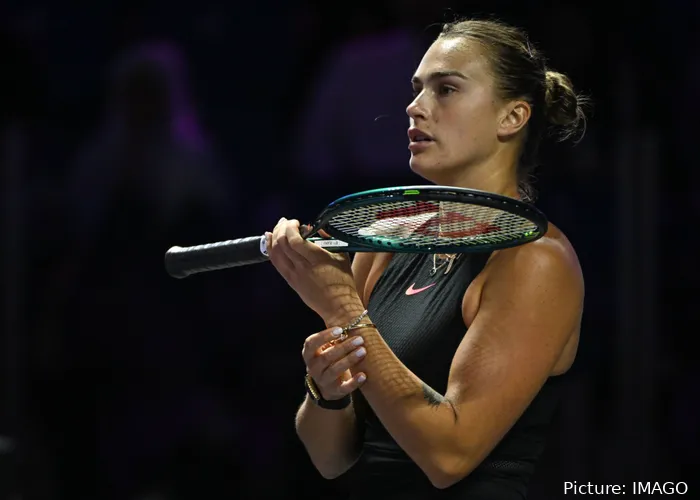
Aryna Sabalenka’s journey to the summit of women’s tennis has been anything but straightforward. The 26-year-old Belarusian star, now ranked as the world number one, recently shared insights into the challenges she faced early in her career. Despite her current standing among tennis elites like Poland’s Iga Swiatek, Sabalenka wasn’t always viewed as a complete player. In fact, she was often criticized as being a one-dimensional powerhouse—a player who relied heavily on sheer force and booming serves without much nuance or finesse in her game.
Reflecting on these perceptions, Sabalenka opened up about how she transformed her game through sheer hard work and perseverance. “I came on tour as the hard-hitter and I’ve been told, I don’t know, for most of my career that I’m not talented and I only can hit balls. I was good at the baseline, probably, and a big server. And that’s it,” she recounted. “I was just a hard worker. I could stay the whole day on court and keep working, keep trying to find the right shot and the right technique for me.”
This perception of being limited in her skill set motivated Sabalenka to prove her critics wrong. She committed to refining her craft, developing not only her powerful baseline game but also adding layers of versatility. Her work with a relatively young coach was pivotal in reshaping her approach to the game. “We started working with my coach who’s actually quite young, but he saw this vision of me where I could not only be an aggressive player but also defend, use the slice, and add more dimensions to my game,” she explained. This transformation didn’t happen overnight, but through persistence and dedication, Sabalenka evolved into a more complete and adaptable competitor.
Sabalenka’s breakthrough season in 2024 was a testament to her hard work. She claimed two Grand Slam titles, lifting the Australian Open trophy after a dominant performance against China’s Qinwen Zheng, which ended in straight sets, 6-3, 6-2. Her victory Down Under marked a significant milestone in her career, establishing her as one of the most formidable players on the circuit. Building on this momentum, Sabalenka continued her winning ways, clinching her second Grand Slam title of the year at the US Open. There, she defeated American Jessica Pegula in another straight-sets victory, 7-5, 7-5. These victories helped Sabalenka displace Swiatek as the top-ranked player in the WTA Rankings.
However, the season was not without its challenges. Sabalenka’s year culminated at the WTA Finals in Riyadh, Saudi Arabia, where she faced stiff competition. In the semifinals, she met America’s Coco Gauff, who ultimately went on to win the title. Despite a valiant effort, Sabalenka fell in straight sets, 7-6, 6-3. The loss was a tough one, but it underscored the progress she has made over the years. Gone is the one-dimensional player of old; Sabalenka now stands as a versatile, resilient, and formidable force in women’s tennis.
Her rise to the top has also come with a shift in how she views her game and her approach to challenges. “Finally, things started working together,” Sabalenka said, reflecting on her development. She emphasized the importance of resilience, consistency, and the willingness to adapt, traits that have defined her career resurgence. While she is still known for her explosive power, her ability to defend, construct points strategically, and incorporate finesse into her game has made her a much more complete player.
Sabalenka’s journey offers inspiration to aspiring tennis players and a valuable lesson about perseverance and self-belief. By confronting and addressing her weaknesses head-on, she transformed from a player with a perceived limited skill set into the world number one. The criticism she faced earlier in her career fueled her determination to work harder and improve, ultimately proving that success in tennis is about more than just raw talent. It’s also about grit, adaptation, and a willingness to evolve.
Looking ahead, Sabalenka has her sights set on maintaining her position at the top of the game and achieving even greater success. She knows that the path she has chosen—one marked by hard work, strategic growth, and continuous self-improvement—will continue to serve her well. As she puts it, “I know there’s still more I can do and more ways to improve my game.” With this mindset, it’s clear that Sabalenka is determined to stay on top and continue redefining what it means to be the best.
In many ways, Sabalenka’s journey encapsulates the spirit of modern tennis—a game where power and precision must coexist, and where players must constantly adapt to stay ahead of the competition. Her transformation serves as a powerful reminder of the value of perseverance, and her story will undoubtedly inspire generations to come. For now, as the reigning world number one, Aryna Sabalenka is living proof that hard work and determination can elevate a player from a so-called “one-dimensional” competitor to the pinnacle of the sport.
Leave a Reply